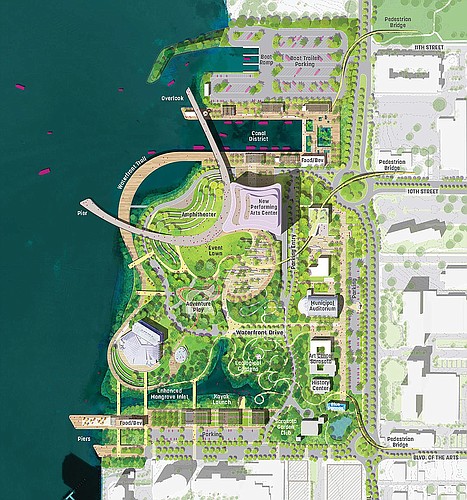- March 10, 2025
-
-
Loading

Loading

Come Sept. 6, the Sarasota Bayfront Planning Organization board — the group charged with creating a master plan for the 53 acres of city-owned bayfront surrounding the Van Wezel Performing Arts Hall — will make its case to the Sarasota City Commission.
It will ask the commission to adopt its vision. To be sure, it’s a grand vision and master plan worthy of that priceless waterfront land, a vision that would catapult Sarasota to a new level, fulfilling much of its potential to be much more than it is already.
If only money were no object.
For this project, estimated between $100 million and $200 million, not including the cost of a new performing arts center, Bill Waddill, managing director of the Sarasota Bayfront Planning Organization, says it likely will take as many as two dozen sources of funding — public-private partnerships, philanthropy, corporate sponsors, retail sales, state and federal tax dollars, bond issues. And this unavoidable reality:
Sarasota city taxpayers, and perhaps Sarasota County taxpayers, will be asked at some point whether they are willing to carry an increased tax burden to finance this grand vision.
City taxpayers will be asked to carry this obligation on top of the city’s unfunded pension liabilities; rising park costs; beach renourishment; the infamous lift station; legal fees, parking subsidies; and the capital costs required to maintain aging water and sewer lines. And as we noted, all of that does not include an estimated $300 million to develop a new performing arts hall — a separate proposition.
Gulp.
With that $400 million to $500 million in mind, and knowing what we all know about Sarasota city commissioners, don’t be surprised if their throats tighten and they put off making the big decisions.
We have an alternate choice: Scrap a new performing arts hall at the Bayfront. As we proposed last December, create a multi-function cultural arts campus at the Sarasota County Fairgrounds on Fruitville Road. In fact, we recently learned outgoing Sarasota County Commissioner Paul Caragiulo has begun efforts to this end.
The case for it is convincing.
Start with the financing. If the growth in tourism continues at its above-average rates — thanks to the additional bed-tax revenue from additional hotel rooms and Airbnb — Sarasota County could cross the $30 million threshold in annual tourist tax revenue by fiscal 2022. (In fiscal 2016-17, revenue totaled $21 million.) This means the county will be able to add a sixth-cent to its existing 5% tourist tax.
The County Commission could then revise the formulas for the bed tax so the equivalent of that new money could be pledged to the annual debt on a bond issue — a big break for local property taxpayers.
Other reasons that site makes sense:
“I could see it happening,” Rory Martin, CEO of the Sarasota County Agricultural Association, told us this week. “Create cultural assets up front and festival grounds on the back. As long as we’re treated as equal partners and not just to make us go away.”
This just may be the time for such a vision to become a reality. All of the association’s buildings are 40 to 60 years old and in need of replacing. What’s more, the association is always barely able to maintain its facilities.
Neither site — the existing Bayfront nor the fairgrounds — is ready to build. But of the two, the fairgrounds could be readied sooner. What’s more, when you combine all of the factors involved — future population growth, accessibility, sources of funding, environmental risk, costs, politics — the case is compelling for a cultural-agricultural campus on the fairgrounds site instead of a new performing arts hall on the Bayfront.
But first, the city and its residents and the county and its residents face a serious dilemma: What comes first? The Sarasota Bayfront Planning Organization’s master plan with a new performing arts hall on the bay? Or a new cultural-agricultural campus at the fairgrounds?
And let’s not forget these projects also vying for taxpayer, tourist-tax, philanthropic and community support: Mote Marine Laboratory and Marie Selby Botanical Gardens.
If money were no object, we would develop them all. But after the Sarasota Bayfront Planning Organization presents its master plan, the questions the community, taxpayers and elected leaders must answer is: Which project takes priority? Which one comes first, second, third?
Let the discussions continue. Visionary leadership is more crucial than ever.